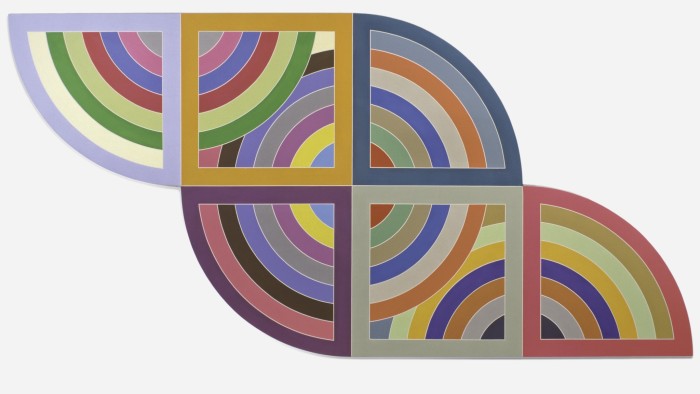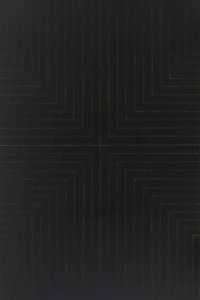Frank Stella: A Retrospective, Whitney, New York: ‘A chaotic mishmash’

Roula Khalaf, Editor of the FT, selects her favourite stories in this weekly newsletter.
Sometime in the late 1980s, the Museum of Modern Art’s venerable curator William Rubin invited me to his home in a beanstalk-like skyscraper high above Manhattan’s East Side. A cinematic view of the skyline dominated the apartment, overwhelming a pair of Picassos and a handful of African sculptures. But not even that urban spectacle could compete with a Frank Stella painting that whirled into the room, amplified the city’s energy, and flung it back across the rooftops like an Olympian lightning bolt.
I thought of that explosive piece in Rubin’s flat when I visited the Stella retrospective at New York’s Whitney Museum, a jumbled extravaganza that tries to rewrite a 60-year career. The gloriously ungainly reliefs from the 1980s reappear in the show and I was thrilled to see them, even scattered haphazardly among earlier and later works. Instead of tracing the artist’s evolution from the monochrome minimalism of the 1950s to his later gaudy freak-outs, the exhibition mixes up various phases, as if trying to prove that they all spring from the same logical spirit. The result is a chaotic mishmash.
The first three galleries are roughly chronological. We see a young Stella honing his canvases into the tight-lipped enigmas that made him famous. In “The Marriage of Reason and Squalor” (1959), thin white lines march in parallel formation across a black canvas, like troops advancing across a vast, monotonous terrain. I’ve never really understood what excited so many people about these depressive exercises. MoMA’s founding curator Alfred Barr admitted that the black paintings “baffled” him, though he was nevertheless impressed by their conviction. To me, they have always looked like statements of bleak arrogance.

Stella trumpeted their simplicity with a smug battle cry: “What you see is what you see.” Eventually, though, he had doubts. By 1970, when Rubin curated the first Stella retrospective at MoMA, the 33-year-old artist was already wriggling free of his pedigreed austerity. He had become so besotted with candy-cane stripes and sugary colours that one reviewer felt he had broken free of logic altogether: “His visual sensibility seems not classic, but frequently baroque. Certainly his adherence to geometry and the way he uses it are far from rational matters.”
Still, Rubin kept the faith. He paid tribute to Stella’s self-reinvention by mounting a second retrospective at MoMA in 1987. That show, effervescing with squiggles, bright cylinders and shiny cones, upset many. How could the paladin of purity have succumbed to such toxic pleasures? And how dare he insist that these aggressive space-hogging constructions were still paintings at all? At this distance it’s hard to summon the fury with which the art world argued the colossally trivial question of what to call Stella’s work. The critic Douglas Crimp, who insisted that the genre had died long ago, wrote that Stella was doing little more than throwing “a tantrum, shrieking and sputtering that the end of painting has not come”. The artist gave six lectures at Harvard to place himself within the grand tradition of Rubens and Caravaggio.
Others felt that Stella was guilty not just of semantic confusion but also of facile showmanship. The New Criterion fulminated: “Beneath the calculated circus glitz there is very little of aesthetic substance in Stella’s reliefs: they claim our attention primarily not as works of art but as exotic optical curiosities. That their novelty and interest tends to fade quickly on re-viewing is a sure sign of their aesthetic poverty.”
Though the Whitney’s director, Adam Weinberg, and Michael Auping, chief curator of the Museum of Modern Art of Fort Worth, organised the current show, Stella had a free enough hand to make an argument of his own: that both the early funereal canvases and the freedom he experienced later on belonged to the same lineage of abstraction. “I would look at my paintings and say, ‘OK, where does that stand next to a de Kooning or a Kline?’” he said recently. “I wouldn’t have been an artist if it weren’t for Abstract Expressionism. That’s what I wanted to be.”
I find that statement difficult to accept as a caption to his whole trajectory, which was far more discontinuous than he makes it seem. The black paintings reject outright Ab Ex’s freewheeling effusions, and the pyrotechnics of the following decades had little to do with the black paintings. Yes, his work from the 1980s has the feel of de Koonings that have burst out of two dimensions into three. But the truth is that Stella turned on himself. He abandoned the parched fundamentals of his early work and gulped down colour, joy and fun. If the later pieces are so disreputable today, it may be because the market favours homogeneity, purity and, above all, recognisability. The early “Abajo”, a pinstriped sheet of taupe resembling a strip of corrugated cardboard, sold at Christies for $6.6m in 2014. The more recent baroque effusions of coloured steel can be had for a tenth of that.
Stella uses the Whitney to let time fold back on itself and hide the fissures in his development, as well as his recent decline. The show opens with a 40-foot acrylic painting, “The Earthquake in Chile” (1999), a clotted and sentimental summary of nearly every idea Stella ever had. The inspiration is a story by the early 19th-century German writer Heinrich von Kleist, who wrestled with extremes of Enlightenment rationalism and Romanticism’s emotional violence. Stella seems to identify with Kleist; he too whips between logic and wildness, making enemies on both sides of the divide.
It’s a measure of Stella’s limitations that his changes of style remain a “problem” after all these years. The concurrent Picasso sculpture show at MoMA similarly veers between periods of sobriety and giddiness, but there all tensions melt in the crucible of that phenomenal imagination. Stella can deny his breakthroughs and 180s, and he can try mightily to persuade the Whitney’s public that he has been steadily chipping away at the same life-long project, but he still seems like an artist permanently at war with himself.
Until February 7, whitney.org
Comments